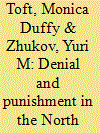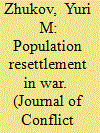|
|
|
Sort Order |
|
|
|
Items / Page
|
|
|
|
|
|
|
| Srl | Item |
| 1 |
ID:
153744


|
|
|
|
|
| Summary/Abstract |
The article considers an option of solving the task of developing a mathematical model of specialized train movement under the conditions of regional conflict in the course of technical reconnaissance, mine clearing, restoration of destroyed railroad sections, and military echelon escort. Impact of various factors on combat tasks performance is assessed.
|
|
|
|
|
|
|
|
|
|
|
|
|
|
|
|
| 2 |
ID:
184010


|
|
|
|
|
| Summary/Abstract |
This paper analyzes maritime piracy acts from 2009 to 2020 using military and mathematical statistics methods. It substantiates the main factors that determine the course and outcome of a forceful act; works out its mathematical model and an artificial neural network for estimating the effectiveness of measures taken to neutralize pirate activity; and gives relevant recommendations.
|
|
|
|
|
|
|
|
|
|
|
|
|
|
|
|
| 3 |
ID:
117630


|
|
|
|
|
| Publication |
2012.
|
| Summary/Abstract |
A growing literature on the subnational diffusion of armed conflict rests on the proposition that political violence triggers more violence, in the same locality and elsewhere. Yet state efforts to contain such uprisings remain largely unexplored, theoretically and empirically. Drawing on a mathematical model of epidemics, we formalize the logic of conflict diffusion and derive conditions under which state coercion might limit the spread of insurgent violence. Using a new dataset of insurgent and government violence in Russia's North Caucasus from 2000 to 2008, we evaluate the relative effectiveness of four coercive strategies: (1) denial, which manipulates the costs of expanding insurgent activity to new locations, (2) punishment, which manipulates the costs of sustained fighting in contested areas, (3) denial and punishment, which does both, and (4) no action, which does neither. We find denial to be most effective at containing insurgent violence. Punishment is least effective, and even counterproductive. Not only does such a strategy fail to prevent the spillover of violence to new locations, but it may amplify the risk of continued fighting in contested areas. In the Caucasus, denial is found to be the least inflammatory counter-insurgency option for Russia. For it to succeed, Russia should physically isolate centers of insurgent activity from regions of nonviolence and avoid the temptation of punitive reprisals.
|
|
|
|
|
|
|
|
|
|
|
|
|
|
|
|
| 4 |
ID:
118749


|
|
|
|
|
| Publication |
2012.
|
| Summary/Abstract |
What would happen to the economies of the former Soviet Union if they finally implemented a full-fledged free trade agreement? How would this change sector output, GDP, prices, international trade, and the economic welfare of the nation? How would it affect the economies of the FSU's other trading partners? This paper attempts to address these and other issues through the use of a computable general equilibrium model (CGE). The model is a large, multi-regional, multi-sectoral, multi-factor system of simultaneous equations. It introduces the "shock" of zero tariffs between all FSU's trading partners, and solves for a new economic equilibrium. There are some political and practical obstacles to the completion of such a trade agreement, so this mathematical model in some ways is just a hypothetical experiment. But an analysis of trade effects can nonetheless be useful to any policymaker in the former Soviet space.
|
|
|
|
|
|
|
|
|
|
|
|
|
|
|
|
| 5 |
ID:
117094


|
|
|
|
|
| Publication |
2012.
|
| Summary/Abstract |
The author has developed a model to predict the way in which events may go in local conflicts in which nonlethal weapons are used.
|
|
|
|
|
|
|
|
|
|
|
|
|
|
|
|
| 6 |
ID:
141704


|
|
|
|
|
| Summary/Abstract |
Why do combatants intentionally uproot civilians? The forcible relocation of families and communities to concentration camps, “protected villages,” and other special settlements is a regular feature of irregular war, occurring in almost a third of all counterinsurgency campaigns since 1816. Despite the historical regularity of these practices, most research has focused on individual decisions to flee, rather than the brute-force resettlement of civilians by combatants. Using a dynamic model of popular support and new micro-level data from Soviet secret police archives, I show that civilian resettlement is not simply a by-product of war but is a rational response to informational asymmetry. Combatants who cannot identify and selectively punish their opponents face incentives to control the population rather than earn its support. For strong governments with limited coercive leverage, civilian resettlement offers a way to reduce rebel activity without having to win hearts and minds.
|
|
|
|
|
|
|
|
|
|
|
|
|
|
|
|
|
|
|
|
|